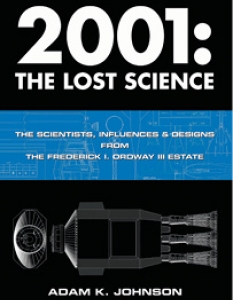The film 2001: A Space Odyssey, released in 1968, has a place in the hearts of many a space buff, mainly because of its depiction of a future replete with shuttles, moon bases and crewed interplanetary spacecraft. This book is a highly-illustrated celebration of that forward-looking film and, in common with the first volume, draws on the archives of the late Fred Ordway, who worked with Stanley Kubrick on the movie. This volume summarises the work of some of the scientists and engineers who influenced Kubrick, Ordway and Arthur C Clarke (the main writing talent on the production team) and depicts some of the spacecraft designs that made it into the film.
By page count it’s a short book but the large format (27 cm x 37 cm) pages and the density of information make up for this. Most of the graphic material is printed on pages with a black background, but in recognition of maintaining the readers’ eyesight the text is standard black on white. Printed predominantly in colour, but with archive material in the original monochrome, this is a very well-produced book.
The early sections provide a fascinating insight into how historical writings and actual work on rocketry provided the background material for science fiction films: from the space station in Hermann Potocnik-alias-Noordung’s 1929 book and Wernher von Braun’s contributions to Collier’s magazine to Walter Dornberger’s writings on rocket-propelled commercial airliners – it’s all here. And we mustn’t forget Willy Ley, Krafft Ehricke, Ernst Stulinger and a host of other characters from those early, German-dominated days of rocket development.
Interestingly, Kubrick originally intended to include a prologue to 2001 featuring interviews with some top scientific minds to prove that his film was plausible. The idea was eventually abandoned and, although the original interview material is believed to have been destroyed, the transcripts remain. The book contains summaries of some of them, including contributions from Freeman Dyson, Fred Durant and Fred Whipple.
The second part of the book shows what the ‘influences’ of the subtitle led to in terms of interior design of spacecraft equipment and external spacecraft design. The four pages depicting the 2001 Moon Bus in multiple elevations (side, front, top, etc) are particularly interesting in that they don’t look like science fiction; one could easily imagine a real moon bus based on this design skimming across the lunar surface.
And that, in a nutshell, is the beauty of the film: even today – almost half a century later – one can imagine seeing these same spacecraft in operation. Unfortunately, the word ‘imagine’ says more about our ability to fund real space exploration than it does about science fiction’s ability to predict it.
Mark Williamson











